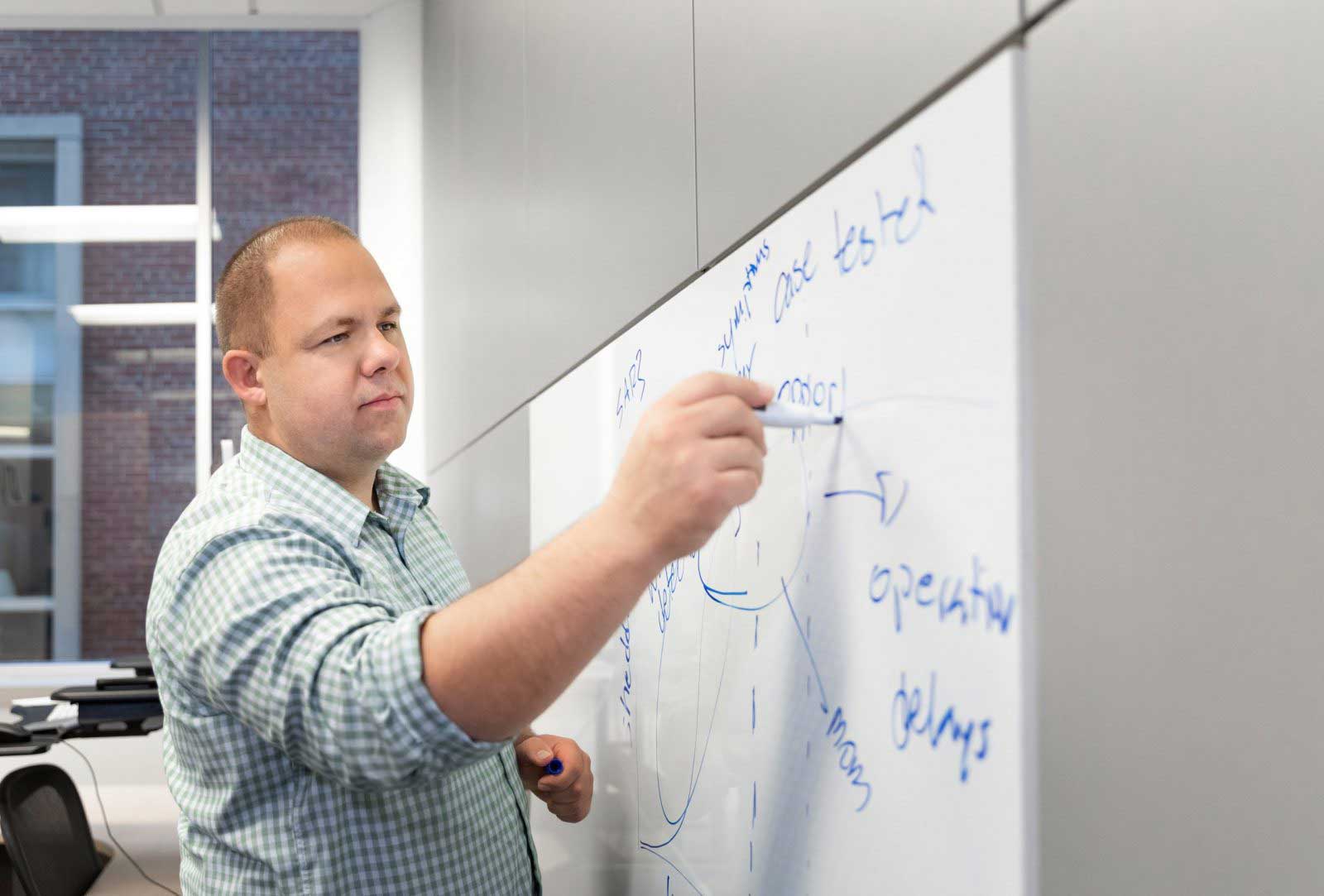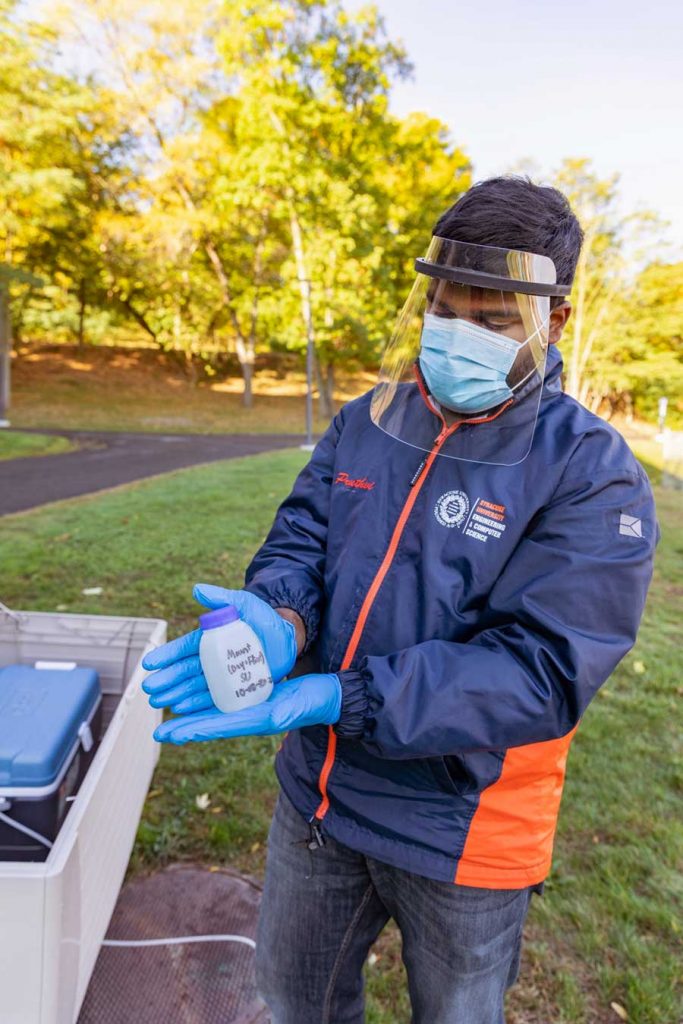
When epidemiologist David Larsen learned last spring that scientists in the Netherlands had detected SARS-Coronavirus-2 in sewage and isolated its RNA, he immediately recognized the significance of their research. “I knew from my experience in global health that it was a big game-changer for the pandemic,” says Larsen, an associate professor of public health at Syracuse University’s Falk College.
In the battle against COVID-19, the ability to monitor local transmission levels is crucial to controlling the virus. Wastewater surveillance—which was implemented a few decades ago to target poliovirus in some countries—acts like a smoke detector, Larsen says. Preliminary research shows it can provide an early alert for COVID-19, allowing public health, medical and health care systems to prepare for an imminent outbreak. Likewise, the absence of the virus in wastewater can help communities make informed decisions about re-engaging in social and economic activities. “It’s all about understanding what real transmission is like in our community—and even potentially showing there’s no transmission,” Larsen says. “That’s where wastewater surveillance can be so useful.”
The idea of establishing an early warning wastewater surveillance platform set Larsen in motion. In March, he reached out across campus and the community to assemble an interdisciplinary team of scientists from Falk, the College of Engineering and Computer Science, SUNY College of Environmental Science and Forestry and SUNY Upstate Medical University. In partnership with Onondaga County and supported by grants from Syracuse University and SUNY-ESF, the team established surveillance efforts in the county and on campus. In August, the New York State Department of Health awarded the team $500,000 to launch a six-week pilot program to expand the platform. By early October, in collaboration with the New York State Association of Counties, they were monitoring 14 counties and 12 universities—and their testing method was proving to be effective. In several instances, including on campus and at various SUNY colleges, they identified the virus in samples, and students were saliva-tested and quarantined until their individual results were known.
The team features experts in microbiology, chemistry, epidemiology, statistical modeling and information science and includes scientists from the state health department and the U.S. Centers for Disease Control and Prevention. As the project expanded, Larsen’s group struck partnerships with Syracuse-based Quadrant Biosciences and the international engineering firm Arcadis, enabling them to meet the growing demand for wastewater sampling and analysis.
Determining a Detection Technique
Many universities and areas around the world have implemented surveillance programs that use different techniques to isolate the virus’s RNA. After exploring several approaches, the Syracuse team locked in on a method that places a sucrose solution underneath a wastewater sample in a test tube and spins it in an ultracentrifuge. “The sucrose cushion purifies out some of the low-density particles and helps purify the RNA that is pelleted to the bottom of the tube,” explains SUNY-ESF environmental microbiologist Hyatt Green, who developed the method with SUNY Upstate clinical microbiologist Frank Middleton. Their technique is comparable in its sensitivity to other methods, requires only a small wastewater sample, and is cost effective and fast, Green says. “A sample can be analyzed in as little as six hours compared to other methods that take 24 to 48 hours.”
Since the novel coronavirus is shed in feces, another key component of their process is determining the amount of a bacteriophage—a common, benign virus that inhabits human gut bacteria—present in their samples. This particular bacteriophage is shed at a known rate, so researchers can draw correlations between that and the virus. “We can use it to account for dilution, population density, and potential decay of SARS-CoV-2 RNA in the wastewater,” Green says. “At the bare minimum, it can be used as a quality control to ensure the recovery of viral RNA.”

Wastewater’s Wealth of Information
According to team member Teng Zeng, analyzing wastewater presents a number of challenges. “Every single wastewater sample is different, and somehow we have to account for the variabilities,” says Zeng, an assistant professor of environmental engineering in the College of Engineering and Computer Science.
Those samples also provide a wealth of information about any given population, Zeng says. For instance, through chemical analysis over a 12-week sampling period, 26 substances were identified, providing information on pharmaceutical consumption patterns and areas where people have underlying conditions and may be more susceptible to the virus. “We can understand whether differences in the population health or behavior could potentially affect the vulnerability and also morbidity of the population to this particular viral attack,” says Teng, who analyzes samples from Onondaga County’s six wastewater treatment plants. “We will see what else we can pick out from a sample, and we can analyze it to get additional data to complement the public health data that most people are interested in.”
Every piece of information gathered can further our understanding of the virus. “When we detect a certain amount of virus in the wastewater, what does it mean for the number of infections in the population?” asks team member and epidemiologist Brittany Kmush, an assistant professor of public health at Falk College. “We don’t really know that yet. It will depend on all sorts of factors, so we’re trying to work on modeling exactly what this signal means for the number of infections.”
Researchers also underscore that wastewater surveillance is just one tool for taking on the virus. As part of its proactive strategy, Syracuse University tests 21 dormitories and several off-campus locations through its surveillance program led by project manager Pruthvi Kilaru ’18, G’20, a Falk public health master’s graduate who was instrumental in designing the program. Kmush, who oversees the saliva-testing program on campus, emphasizes that knowledge about the virus continues to grow and our response to the evolving information requires vigilance. “Science is always changing,” she says. “This virus didn’t exist last November, so we’re constantly learning about it and using what tools we have available to make our most informed decisions. Sometimes we get different or better answers, and then we have to change our course of action to follow the latest science.”
An SU Story by Jay Cox, originally published on October 27, 2020.
